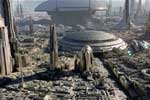They have worked on five of the ten biggest box-office hits in history.
They have made possible
iconic images which will stay permanently
in the retina of those who grew up with them: from the attack of
rebel spaceships on the
Death Star, to the most realistic
dinosaurs ever seen on screen. Not forgetting the impossible
sequence where
Tom Hanks shook hands with
president Kennedy,
or the unforgetable silhouette of
ET the Extra-Terrestrial
and his friend Elliot standing out against the Moon. Industrial
Light & Magic, ILM, is much more than
the biggest special
effects company in the world. Their legacy has completely changed
the way films are shot, the visual vocabulary at the disposal of
filmmakers, and even the ontological status of the image in contemporary
culture.
It's difficult to overstate the influence ILM has exerted on
the industry and art of cinema in the last three decades. The
scientists, artists and multidisciplinary creatives called together
by George Lucas in the north of California in the
middle of the 70s to make the dream of his galactic saga possible
provided filmmakers such as Spielberg, Zemeckis or Lucas
himself with the visual devices they needed to reinvent Hollywood.
The result is the model of global-scope blockbuster which has
controlled worldwide box offices up to the present day. But ILM
has also been one of the most important research and development
laboratories of image technology. The possibilities opened up
by these techniques and tools have changed the way films are made
at least in the same way that word processors have changed the
way novels are written; even having an influence on directors
who are diametrically opposed to visual effects films. (Among
these directors who have asked ILM for help more than once in
the last years we can find, for example, Woody Allen).
Finally, since 1982 when they used it for the first time in the
second chapter of "Star Trek", Lucas' company
may have been the main driving force of computer animation as
a creative discipline. Image synthesis has become a huge industry
these days fixing tens of thousands of artists worldwide with
a job and being present in every field of audiovisual production.
2005 has been a special year within ILM. The Saga of
Star Wars, the series of films which caused the creation of
the company thirty years ago, was completed in order to show at
last the central fact in the galactic mythology: Anakin Skywalker's
fall to the dark side and his transformation into Darth Vader.
As expected, Lucas' best men have devoted themselves to the most
complex project ever dealt with in an unprecedented visual show.
Episode III means the crowning achievement of all techniques
developped for the two previous parts: countless digital sets
of great diversity, more and more virtual actors, and a huge number
of different elements absolutely everywhere in every shot.
"Revenge of the Sith" has not been the only
ambitious project produced by ILM this year. If Lucas' films are,
for obvious reasons, those which demand more efforts from the
company, those films produced by the other flagship director,
Steven Spielberg, follow them closely. The new version
of the classical "War of the Worlds" by H.G Wells
required a different treatment to the usual big productions of
special effects, more subtle and realistic, concealing in the
shade those terrors that the story hides. The task requires twelve
weeks of work at a relentless pace for hundreds of animators headed
by two of the most famous visual effects supervisors in the company,
the legendary Dennis Muren and the Argentinian Pablo
Helman.
About to enter their fourth decade of life, ILM promises to keep
offering unprecedented and spectacular visual shows. From their
bright new installations in San Francisco, where they have
recently moved after a whole life hidden in unidentified big industrial
premises, the company is already working on twelve new productions
which will be premiered throughout next year.
Founded in 1975 by George Lucas to create the wonderful
universe of the "Star Wars" trilogy, Industrial Light
& Magic is without a doubt the most important visual effects
company in the world. Fourteen Oscar awards, more than two hundred
films behind them, and their crucial contributions to disciplines
such as digital image synthesis have turned ILM into one of the
most important stars in the film world of the last three decades.
Pablo Helman from Argentina is one of the present visual effects
supervisors in ILM, (the highest post on the scale within special
effects industry). He has worked in the second "Star Wars"
trilogy and in productions such as "Apollo XIII", "Saving
Private Ryan", "Contact" or "Jurassic Park
II: The Lost World". As a visual effects supervisor, he has
been one of the main heads in the recent "War of the Worlds".
Text originally published in ArtFutura's 2005 catalog.






